These pluteus are a common edible mushroom of gardens and the edges of woods. They're relatively easy to identify, and a mushroom I will collect if I see them.
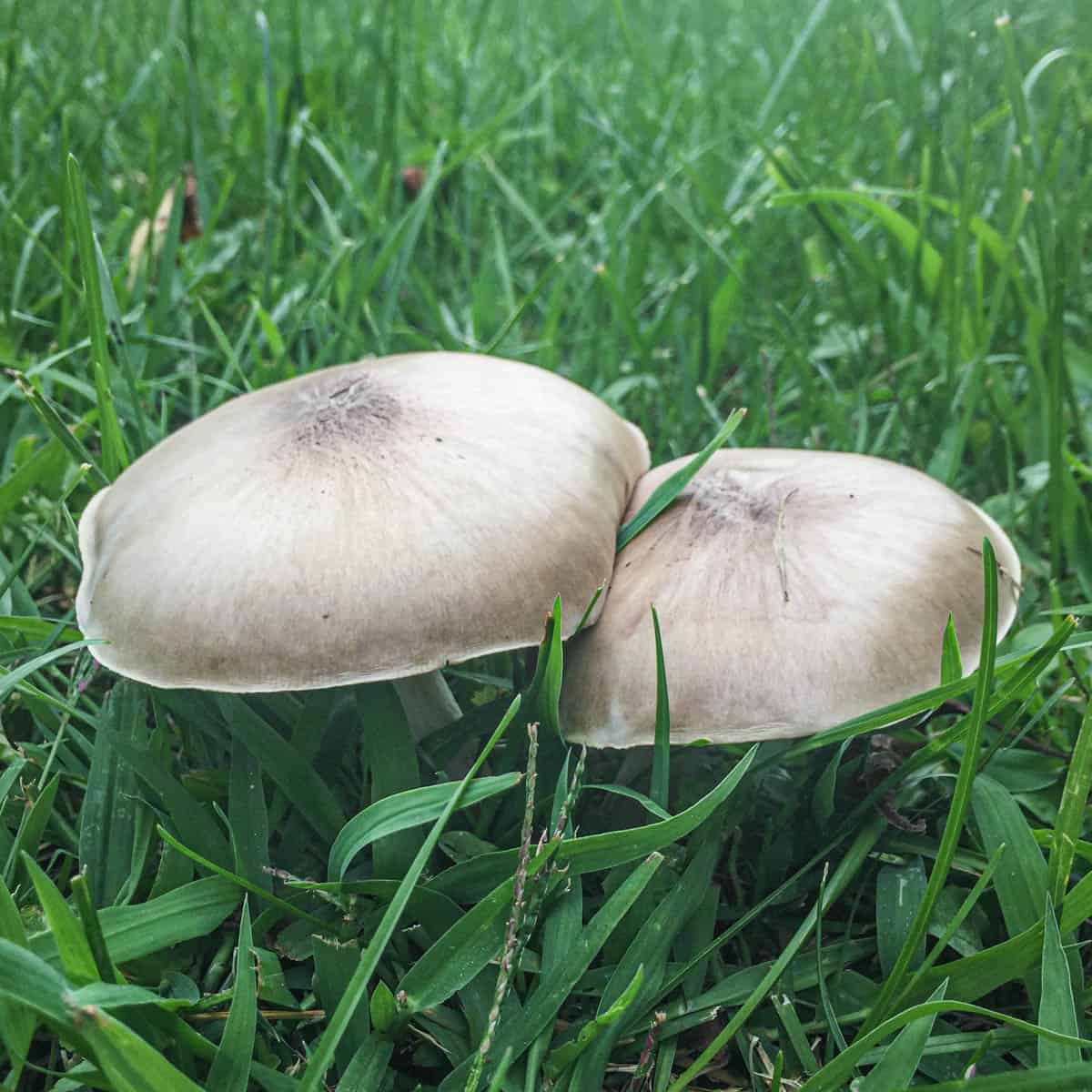
After the morels have come and gone in Minnesota, there's a bit of a variety season and deer mushrooms, also known as the fawn, is one of the first you might see.
They're graceful mushrooms that loves to pop up here and there in yards, open spaces, and in the woods on logs, depending on the exact species. Oddly enough, the name deer mushroom is pretty accurate, as I do see deer occasionally eating these mushrooms, as well as squirrels.
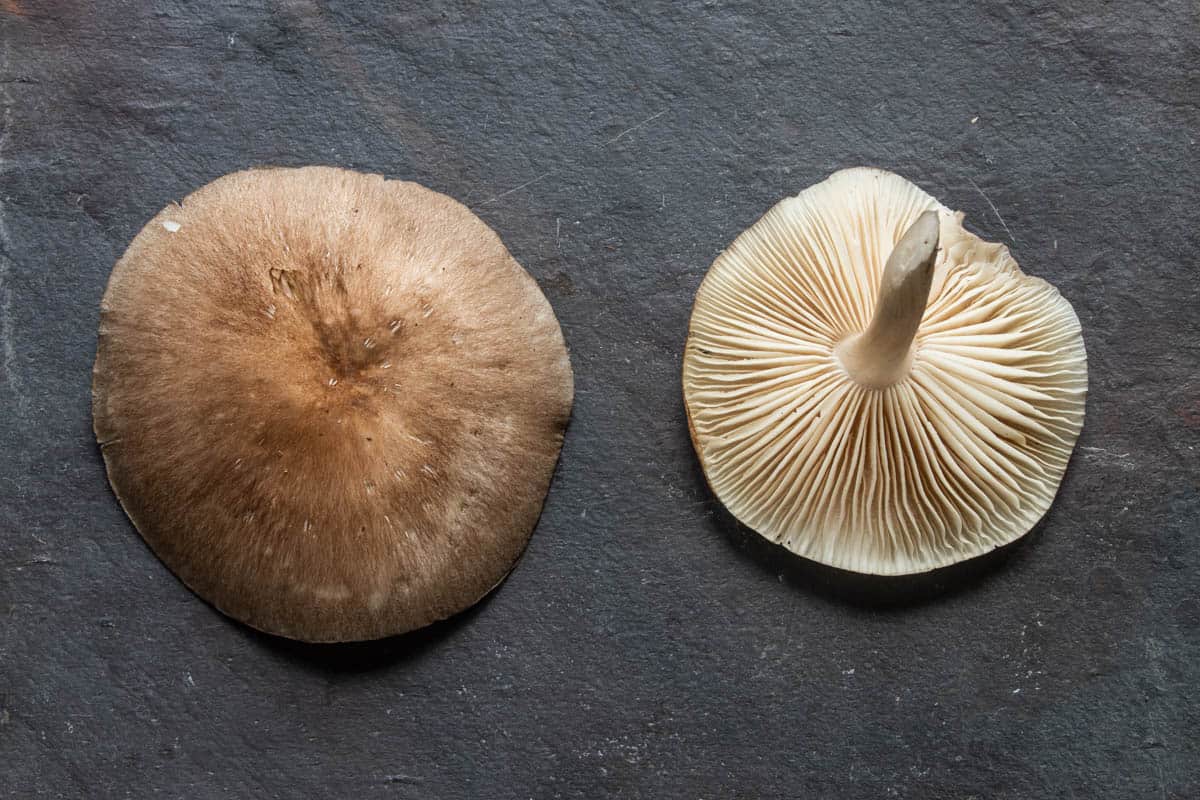
For the purposes of this post, I'm grouping the two I refer to as deer mushrooms together: Pluteus pestatus, which I usually see in yards, and Pluteus cervinus, that I typically see in woods growing from dead logs. I don't usually see these in huge fruitings, more or less there will be one or two here, then a couple there. They're relatively easy to identify with a basic knowledge of mushroom I.D. techniques, and are worth collecting once in a while if there is nothing else, although there's definitely better wild mushrooms out there to harvest.
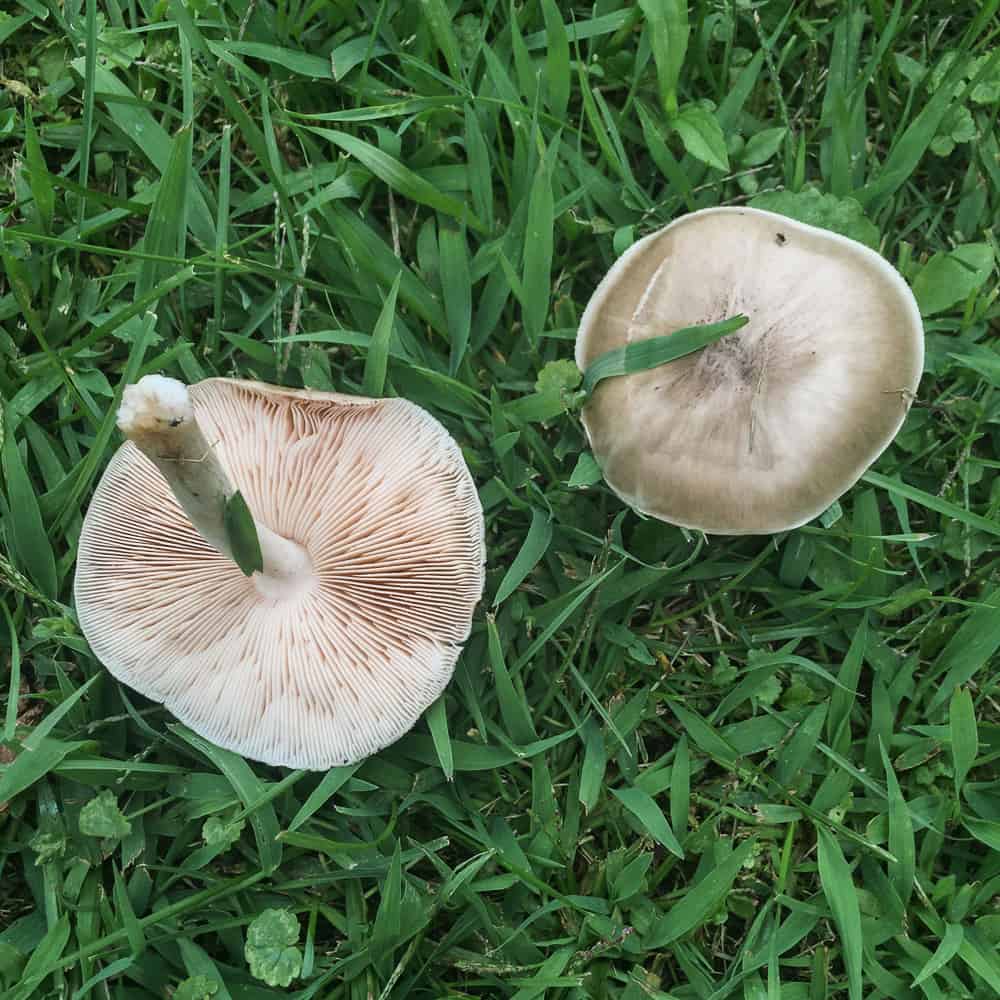
Identification
- The fawn mushroom has a tell tale "nipple" on its cap, called being umbonate.
- Very young mushrooms may have a totally brown cap.
- These are decent sized mushrooms, I usually pick ones that have caps at least 4 inches in diameter.
- As the mushroom grows older, it's cap might flip up like an umbrella as it shoots its spores and matures.
- The cap may develop little cuts or slices in it as it grows, almost looking like someone sliced it with a knife, or cut small chunks from it.
- The gills of the mushroom have a sort of pinkish red tint to them.
- Notice in the picture below that the gills also do not touch the stem.
- These always grow directly from wood, but remember to check the ground for signs of former trees, since mushrooms can grow from buried wood too.
- There will never be a "sac" or anything at the base of its stem resembling an egg, also the stem is totally bare and clean, with no evidence of any kind of ring or other decorations.
- The cap is composed mostly of gills that are packed tightly together, it's thick, bushy, and brittle.
- Pluteus pestatus and cervinus have a pink-ish spore print. If you have a white spore print, you should compare your mushrooms with Megacollybia rodmanii.
- Some Pluteus should probably not be eaten-If your stems bruise blue, discard them.
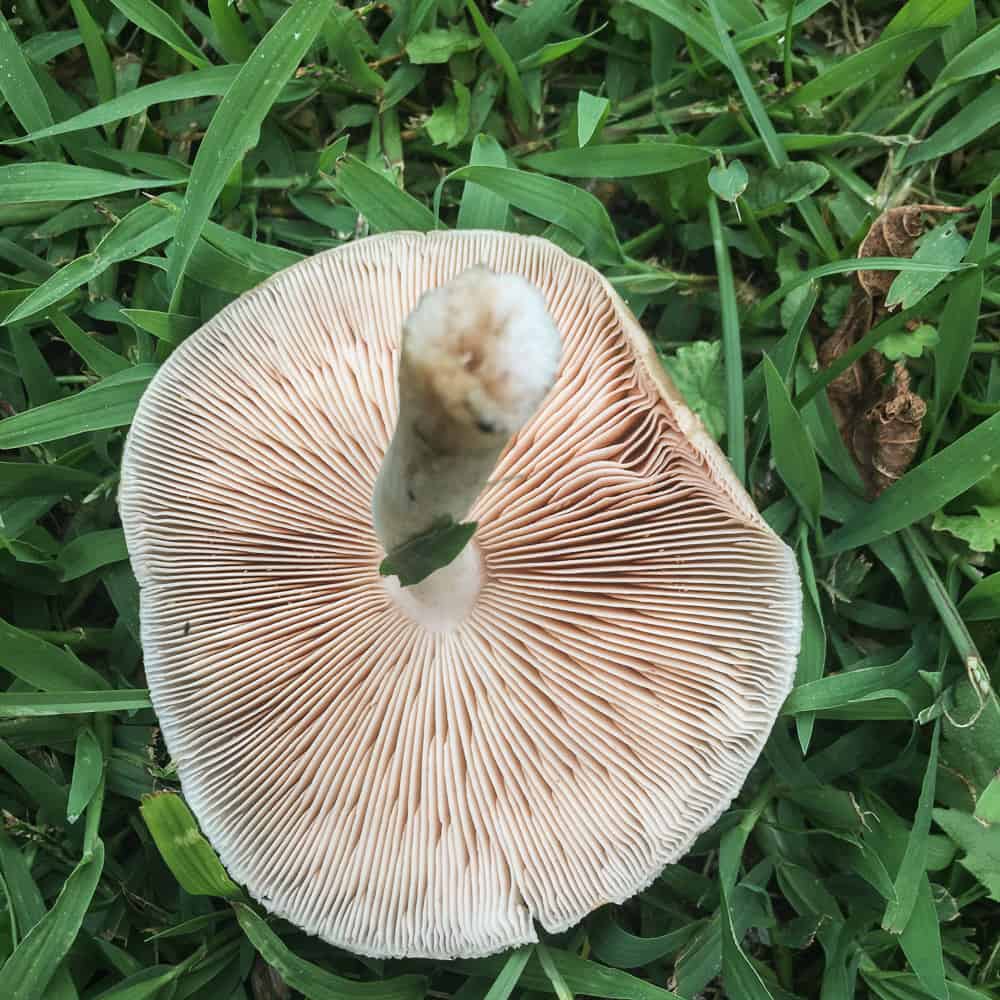
Look A Likes
There's a few look a likes for deer mushrooms, but, thankfully they're easy to separate from the baddies, and, personally, I find the mushroom most often called a "look a like" for these a bit of a stretch, but mushrooms can be confusing, especially if it's your first time.
Galerina marginata
Galerina marginata, also known as the funeral bell, is a lethally toxic mushroom that can also grow from wood. But, don't be scared-they're easy to separate from most mushrooms with a quick inspection. Here's a quick list of the differences:
Galerina
- Has an orange-brown cap
- Is smaller than most Pluteus
- Has a brown spore print
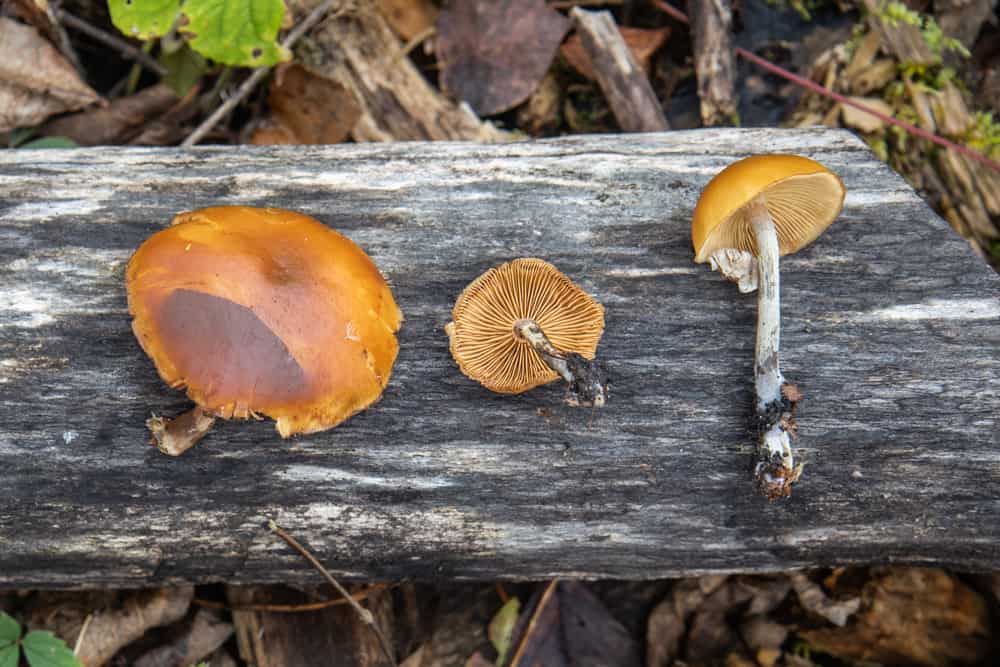
Cooking
Pluteus are ok, but they're delicate and brittle, so make sure you put them in a basket and keep them safe, otherwise you'll wind up with mushroom crumbs when you get home. They have an interesting radish flavor and aroma, which can be more noticeable with some species than others.
If you smell the gills close up, you will notice a definite aroma of radishes. If you caramelize and brown them in a pan, this flavor leaves and they take on a taste that's more mushroomy and earthy. If you stew them, without caramelizing, the radish flavor will remain. One of my favorite ways to cook them is sauteing the caps whole and tossing with garlic and parsley, as below.
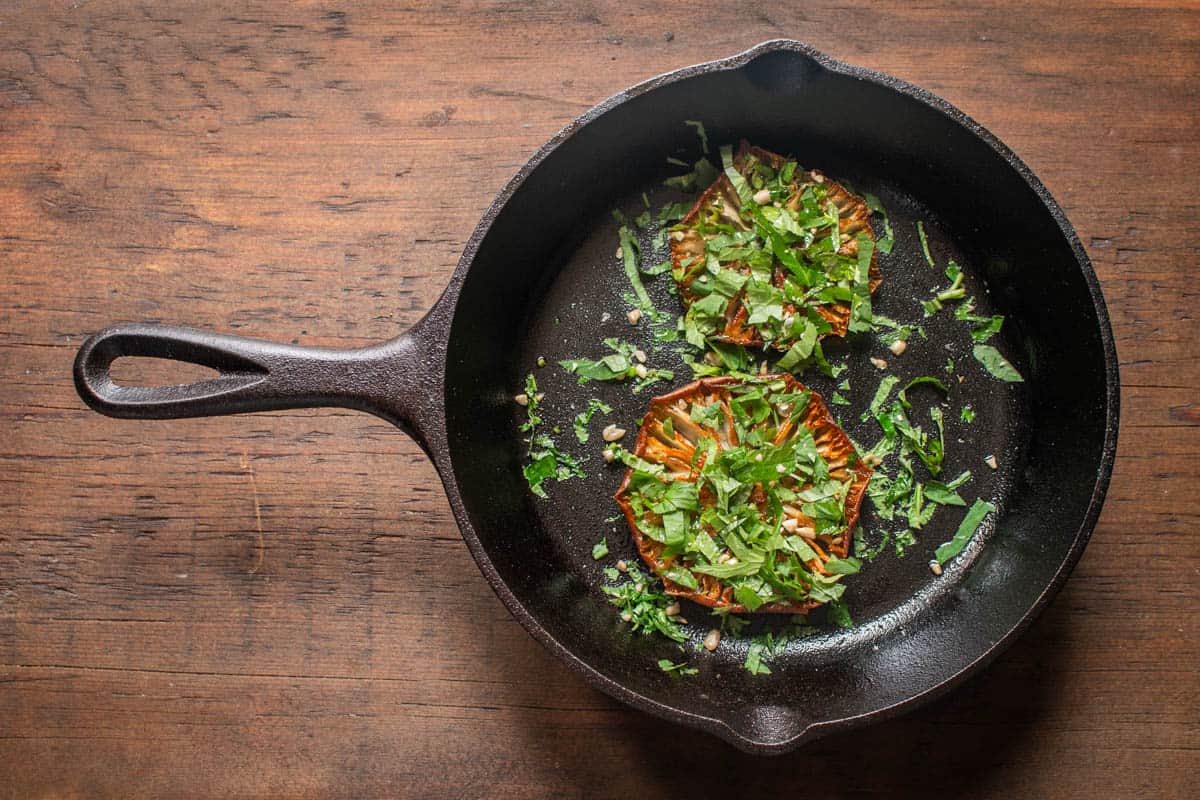
If, by some stroke of luck you find enough to preserve them for later use there's plenty of options. Deer mushrooms can be sliced and dried easily, or even left whole, although, unlike most other mushrooms, the flavor doesn't seem to really improve from drying. They have a mild flavor after re-hydrating that's a decent addition to a stock or soup. Pickling them is always a fine option too, refer to my basic recipe for mushroom conserve.
Recipes
- Wild Mushrooms With Garlic And Parsley
- Wild Mushrooms With Breadcrumbs, Garlic, And Chili
- Hedgehog Mushroom Conserve
- Hedgehog Mushroom Duxelles
- Bison-Black Barley Stew, With Wild Mushrooms
Deer Mushroom Caps with Garlic and Parsley
Ingredients
- 2-4 Large, clean pluteus caps
- 1 Tablespoon cooking oil or butter, or a mix
- 2 tablespoons chopped Italian parsley
- 1 large clove garlic
- Kosher salt and fresh ground black pepper
- Lemon wedges, for serving optional
Instructions
- Inspect the mushrooms and dust them of any grit, wood or debris.
- Cut the stems from mushroom and slice them into ½ inch pieces.
- In a saute pan, such as a 10 inch size, heat the oil or butter, then add the mushroom caps and cook, turning occasionally, until browned on both sides and the water has evaporated.
- If the mushrooms soak up all the oil, add another drizzle to the pan now.
- Season the mushrooms with salt, add the garlic and stir, cooking for a minute or two until the garlic is aromatic.
- Turn the heat off. Add the parsley, stir to mix, then arrange the mushroom stems on top of the caps. Sprinkle with a little extra parsley and serve with a wedge of lemon.

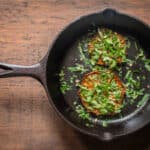
Jenn
Thank you! I haven't tried the recipe yet but your ID info on the deer/fawn shrooms was invaluable and I feel more confident revisiting the ones found in nearby greenspace now for potential harvesting. Also, following your work now chef.;)
Alan Bergo
Thanks Jenn.
Erik van Overloop
I don't think it is reasonable to deliver such a rude comment since it reflects the way you perceive the world! Be frantic and life will be frantic. Kindness and appreciation goes a long way, just try it, you'll feel better! Was meant for the one that reacted rude to you Alan.
Anna
It was very helpful.
Thank you for the detail descriptions and explanations.
David
It should be noted that many mushrooms of this genus such as Americanus, saupei, salicinus and others contain notable amounts of psilocybin, and are easily confused with cervinus.
Alan Bergo
Thanks David.
Unhappy With Your Site
Man, your ads are a really nuisance! How can anyone concentrate with this agressive bs constantly in your face?! It's such a pathetic world we live in, that this setup is now somehow standard and everyone everywhere somehow considers this reasonable. Shame on you!!!
Alan Bergo
For 7 years I wrote and maintained this site, paying the costs out of pocket. Over the years as it grew, the costs increased to the point where I couldn’t afford it. As of 2023, I have 10+ subscriptions that help keep this site functioning. It ads up to the cost of a part time income. The ads keep this site and the 10 years of work I’ve put into it free like the wild food it represents.
Kelly
Thank you for this channel!
Alan Bergo
Thanks Kelly.
Anna
It was very helpful.
Thank you for the detail descriptions and explanations.
Dave H
I really appreciate the work you’ve done. I used some of your cooking ideas with great success!
I’ve never been bothered by ads, don’t understand why that guy would complain.
Alan Bergo
Thanks Dave. I mean we just have to be realistic here. At first the site was cheap to run and I soaked up the costs without any monetization for 8 years, which is unheard of in my world. 13 years later it's grown alot. It costs me multiple 5 figures a year to run this site, and I can't pay in acorns.
Erik van Overloop
I don't think it is reasonable to deliver such a rude comment since it reflects the way you perceive the world! Be frantic and life will be frantic. Kindness and appreciation goes a long way, just try it, you'll feel better!
Ellen
Do you have any idea how much work goes into creating content for a website? Do you work for free? I imagine you receive a paycheck for the work you do. Why would you expect anyone else to work for free? For what Forager Chef offers, it’s worth a little inconvenience. Alan’s time and effort deserves to be valued.
Shroomy Shona
I just found one beauty up in the woods near Ashville NC. A lovely silver gray color. Did a spore print. It was not pink but rust-ish brown. All other details match. I am not eating it just to be safe. Thanks fro all the info.
Alan Bergo
Thanks Shona.
Maria
Thank you for such great information. At the beginning of 2022 I stared to be interested in everything about edible mushrooms so I started cultivating them at home but also, I use to go hiking to the nearest parks and forest to find out more and try to identifying mushrooms. I love to do this as a hobby! I have a YouTube page in case you wants to take a look. m.m.h.g. Don’t stop shinning
Thanks,
Maria 🙂
Alan Bergo
Thanks Maria.
Michael
Just found my first mess these here in west central Missouri. Been hunting and eating verified edible wild mushrooms for around 20 years now, mostly morels but always ready to try something new especially when morel season is long gone. Found about6 nice sized fresh ones growing on a stack of unsplit firewood! Think I'll try preparing with chopped bacon, fresh onion and a few garlic cloves. Happy hunting!!!
Michael Norris
Do they grow in north america, and do they prefer deciduous or conifers or like both? does it have a mucous layer and are those markings always present on the cap? i found some similar in washington state. they were in a wooded area mostly maple and filbert there, tho heavily wooded with conifers in other parts of the area not far from where they were specifically. they were under ferns base seemingly in dirt but there easily could have been pieces of maple decomposing under the surface. any help is appreciated..
Christina
I live in NE Texas. Found commonly here. https://www.mushroomexpert.com/pluteus_cervinus.html
Kevin
Sorry to butt in here, but for the sake of avoiding (potentially dangerous!) confusion, the "free" gill type is NOT called adnate. Adnate means attached at the stipe. I doubt your readers will read this far into the comments section so perhaps you could edit that? Thank you for the information on edibility and cooking!
Alan Bergo
Hey Kevin, yeah I don't know how that mistake has survived in here, thanks for catching it.
Kathleen Rodgers
We have been getting the pestasatis variety here courtesy of the power company.I have not tried this one and we will see how it cooks.
Dan Farmer
Thanks for teaching me about these, Alan. I have since found several more. However, I do find that they are just about impossible to get home in less than 100 pieces; delicate little suckers that they are.
Alan Bergo
The caps are very delicate, when stewed fresh they have a pleasant taste with a hint of spicy radish. I have a stump in the backyard these grow off of, like a natural garden. There are at least two different species I have seen in minnesota from this family (pluteus) and I have eaten and enjoyed both of them. I separate the caps from the stems when cooking.
Geralyn_D
I love these mushrooms and go foraging prepared with my flat basket and sometimes if caught without it I simply field dress (gently press the center cap with fingers spread under it to dislodge the stem) and stack them if you are so fortunate as to find enough for a meal. I call these my bacon mushrooms and fry them CRISP in butter and season the gill side with poultry seasoning. use them where bacon is served, also as the shrimp component in green papaya salad, also chipped into rice stir fries. Mmmm... I have only tasted the radish flavor when raw and only for verifying mushroom type. I have never stewed these lovelies as I covet them for savory use and cannot get enough of them. This is a mushroom that may grow on you... always verify them (the lead in picture is a bit misleading) they do NOT grow from earth or grass UNLESS there is a root or log under it! Always see the wood substrate and then confirm the pinkish spores in the gill area.